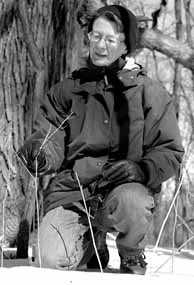 |
|
Making the Cut by Chad Boutin
Let's just say she's not an equal-opportunity tree-hugger.
She is walking through Big Woods, the largest forest on the Fermilab site. ìYou see all these elms and basswoods?" she says, pointing at the wrist-thin trees surrounding us. They contrast sharply with the stately bur oak we are approaching; even its upper branches are thicker than smaller trees. But the oak is alone among thousands of thin trees, and few other plants are visible.
"Because of these weedy young trees, light isn't hitting the forest floor," she says. "That makes it tough for many native plants to grow. So we are going to remove some of the young trees and watch how the ground flora recovers."
Recovery begins this month. Aicher and her team will cut down all the weedy trees less than 10" in diameter on three circular plots in the Big Woods. The plots are 40 meters in diameter, and each centers on a bur oak dating from precolonial days. Aicher plans to monitor the sites for at least five years to see how many and what kinds of native plants grow back.
"After a year," she says, "I'll probably seed with grasses, forbs, and sedges as well. We'd like to get the ecosystem close to its presettlement state. The goal here is biodiversity."
It's a worthy goal for any ecosystem. But aren't the younger trees part of the ecosystem as well? Why are native plants having so much trouble on their home turf?
Understanding the trouble requires a vision of how a native woodland fluctuates within a natural prairie ecosystem. And that vision would be incomplete without fire.
"Like southern Wisconsin, northern Illinois is traditionally fire-adapted savannah," says Mark Leach, who manages research programs at the University of Wisconsin-Madison Arboretum. "Prairie fires would over time keep out the trees that are more shade-tolerant, like maples and elms. They would get cooked in a fire while bur oaks would keep growing, because their bark and roots are very fire resistant. The grasses would burn, but their taproots, like those of the oaks, would allow them to grow back quickly."
"We had this highly flammable landscape, so as a result we have prairie vegetation that is adapted to having more light," Leach adds. "To bring it back requires that we remove other trees ourselves, because we can't just let wildfires go anymore."
Less than a year after wildfires ravaged the American West, few need to be reminded of such danger. The Department of Energy's Los Alamos National Laboratory was damaged in last year's disastrous blaze, which was itself begun as a prescribed burn. When the blaze raged out of control, the lab had to be evacuated for nearly two weeks.
"We don't have any potential for runaway fires in this part of the country," says Rod Walton of Fermilab's Facilities Engineering Services Section, who is working with Aicher on the project. "But because of Los Alamos, there is still a moratorium on controlled burns on all DOE national lab sites. So we may be able to manage the sites somewhat using natural methods."
Prairie restoration has been an ongoing process at Fermilab for a quarter-century. Since then, over 1200 acres of prairie have been returned to a wild state. Aicher's project is one of the first to focus on Fermilab's woodlands, and will eventually help transform even more lab property into a functioning ecosystem. But it is just the first step.
"Right now we aren't restoring anything, but we hope that what we learn will lead to better restoration efforts in the future," Aicher says. "Our problem with light is not just with the trees. We also have a big problem with invasive species from Europe like garlic mustard, which shades out all the other plants. Without native food source plants to support ants, mice and owls, the whole ecosystem gets out of balance."
Close observation of her three plots should yield the information she and other ecologists need to bring ecosystems back to their original equilibrium, or at least as close as they can manage.
"Hopefully, you someday get to a point where the ecosystem is self-sustaining," Walton says. "But that's pretty much impossible on a site this size. You have to manage it."
For the moment, Liz Aicher will focus on letting in the light.
|
| last modified 3/15/2001 by C. Hebert email Fermilab |
FRLsDFx9eyfrPXgV
 Environmentalists generally want to save trees. So why is Liz Aicher cutting down circles of them in a Fermilab forest, leaving a single lonely oak standing at the center of each circle?
Environmentalists generally want to save trees. So why is Liz Aicher cutting down circles of them in a Fermilab forest, leaving a single lonely oak standing at the center of each circle?
 Eventually, Leach explains, only scattered stands of oak would punctuate the prairie, giving lower-growing prairie plants plenty of sunlight.
Eventually, Leach explains, only scattered stands of oak would punctuate the prairie, giving lower-growing prairie plants plenty of sunlight.